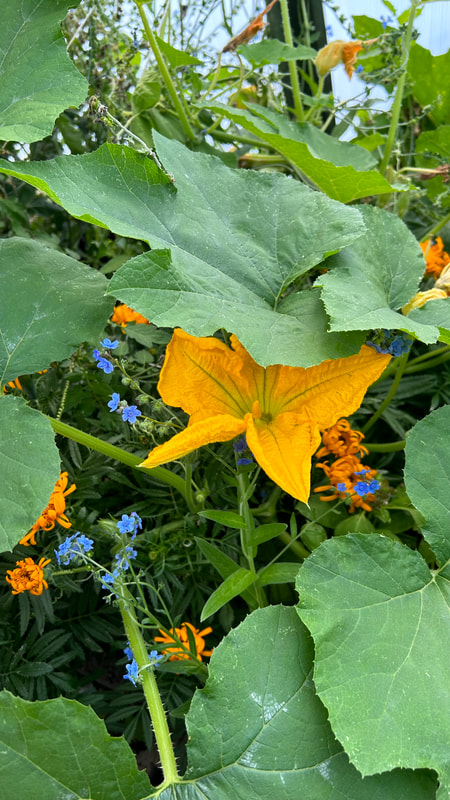Rosemary LoganCheckout the Spring 2020 section of NAU's two-semester Permaculture Design Course Blog! Archives
December 2023
Categories |
Back to Blog
Ben Steller & Mariessa FowlerPermaculture students At the beginning of this field trip, we met with Phyllis Hogan at the Michael Moore Medicinal Garden to talk about medicinal plants and ethnobotany in the Southwest. Phyllis Hogan is a longtime ethnobotanist in the four corners region. In 1976, she created her store in Flagstaff, Arizona, called Winter Sun Trading Co. This local store specializes in the selling of herbal medicinal and local Indigenous art. Then, in 1983, she co-founded the Arizona Ethnobotanical Research Association. This vaulted her into ethnobotanical prominence in the four corners region, and she has been positively contributing to this region ever since. To begin her talk, Phyllis introduced us first to her and her backstory, and then to her methods of honorably and holistically harvesting plants. As she described it, harvesting plants is a privilege and must not be taken lightly. She described how first, one must burn juniper as a method of connecting with plants and connecting with our ancestors. Then she described how we should make a prayer offering to the plant and to the sun. In this prayer offering, she instructed us to tell the plant who we are, and that we should ask for permission to pick it. If it gives us permission, then take responsibility and never overharvest. And if it does not give us permission, she instructed us to never violate that expression from the plant. Only if you go through all of these steps and receive appropriate permission from the plant can you then harvest. For this field trip, we met at the Michael Moore Medicinal Garden. This garden is located on the property of the Museum of Northern Arizona, and it was formerly a parking lot. Now, it is an herbal medicinal garden named after another renowned ethnobotanist of the region, Mr. Michael Moore. This medicinal garden, named after him, is filled to the brim with beautiful medicinal herbs with all sorts of uses. Phyllis showed us examples of some of these herbs from her own collection, among them being the osha root and the yucca root liquid. Both of these have medicinal uses as anti-inflammatory plants. In the garden, we saw lots of sage and various types of medicinal flowers. After touring this garden, we headed up to the Colton Community Garden. The Colton Garden was located right behind the Michael Moore garden and is a communal garden site for the community of Flagstaff. We met with one of the main people who manages the garden, her name is Fitz. She first went over seed saving and how it differs by region. Also how important seeds are because they have genetics and store information. Moreover how you need seeds in order to grow things. For certain seeds, the method of seed saving is different because tomatoes and cucumbers are wet, they require water to germinate. It creates mold which then breaks down the wet layer and you are left with dry seeds. For dry seeds, the process is also different. Community building and sharing is experienced through seed saving. People share their seeds with their neighbors and it usually is for plants that best suit their climate. Then Fitz discussed their favorite vegetable, beans! There are so many varieties of beans especially in this region. Beans grow really well in the Flagstaff region and are beneficial to the soil due to its nitrogen properties. Also they are really good for storing in the winter time and you just need to save a certain percentage for the upcoming growing season. After this demonstration of seed saving and beans overview, we explored the garden. There were a variety of displays for different gardening techniques like keyhole gardening, community composting, sheet mulching, zuni waffle layout, hoop houses, arch trellis for squash, passive solar greenhouses, intercropping, three sisters method, permaculture, and even an indigenous crops garden for a program with indigenous flagstaff students. The keyhole method is best summarized as a compost bin built into the middle of a raised bed. It gives the garden bed the ability to retain moisture, nourish the soil, and improve productivity. The Zuni waffle design is when garden beds are sunken in squares covered with clay or soil walls that keeps water enclosed in these circles. They are efficient in conserving water and improving moisture. The Colton Garden also has a space for children and there is a separate area for children to play. It's behind some willows and connected by a tunnel. There are different books and activities left there for children to interact with while they are there. The kids learn how to plant and harvest. They are currently in the process of creating a geodome for the children to do more planting and growing opportunities. The Colton Garden is very community oriented and actually hosts a lot of events involving the community like workshops and farmer markets. They are open for compost and food scrap collection. But the garden is very inclusive and we can definitely learn from them!
0 Comments
Read More
Leave a Reply. |
 RSS Feed
RSS Feed

















